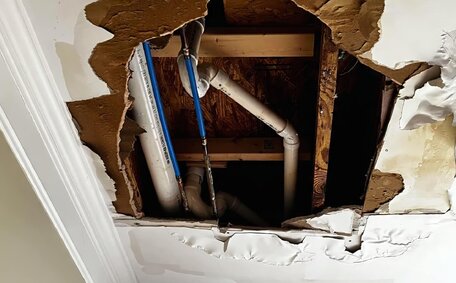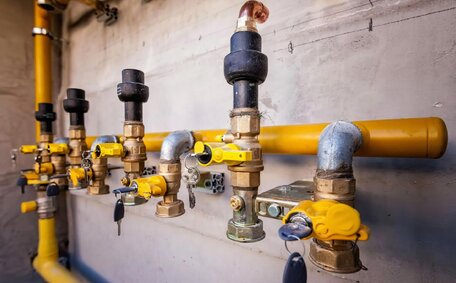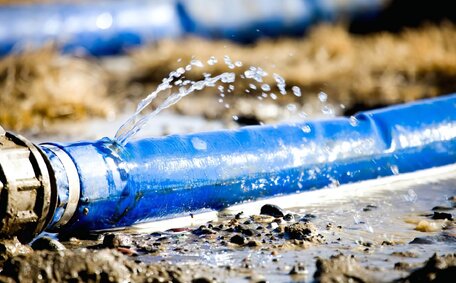Introduction to Gas Fitting in Kitchen Renovations
Upgrading gas lines and installing appliances are crucial in kitchen renovation for the safety and efficiency of stoves, ovens, and cooktops.
As licenced gas fitting specialists based in Lindfield, Sydney, Lindfield Plumbing brings expertise in designing, installing, and testing gas systems to meet the latest standards.
This guide details essential considerations for gas fitting in kitchen renovations to inform homeowners about the process. We’ll cover planning gas needs, selecting licensed professionals, safety protocols, benefits of gas appliances, and guidelines for choosing skilled gas fitters.
Understanding the Gas Rough-In and Fit-Off Process
Gas rough-in and fit-off are critical stages when installing gas lines and appliances such as gas stoves in any kitchen renovation. The rough-in stage includes laying out gas pipes and planning connections early on, whereas the fit-off involves testing and commissioning the gas components for use.
Meticulous planning is critical to ensure the gas system aligns with the kitchen layout and appliances specified. Our team conducts thorough site surveys and measurements to establish the best routes and points for gas connections.
We install rigid copper plumbing pipes and flexible connectors as per Australian Standards, allowing some flexibility if appliances or cabinets shift during later construction.
The fit-off process for the gas connection cannot occur until the kitchen’s joinery, tiling, and sink installations are finished. Lindfield Plumbing returns on-site to connect cooktops, ovens and other gas elements, making any minor adjustments needed to pipework. We then test and certify the entire system, checking for leaks, ensuring flame quality, and confirming it operates safely and efficiently.
Compliance certificates are issued upon satisfaction with the installation.
Enlisting qualified gas fitters like Lindfield Plumbing for both stages provides homeowners assurance that all work adheres to safety codes. We also provide gas appliance selection advice and can coordinate orders across related trades.
Gas Pipe Installation
Gas pipes are the lifelines for kitchen appliances, ensuring a safe and efficient energy supply. A qualified gas fitter’s correct installation guarantees the safe operation of appliances, including the hot water system, to meet cooking and heating demands.
We use rigid copper and flexible connectors for all internal gas lines, selected based on required capacity and compliance with Australian Standards. Rigid pipes offer durability but allow some flexibility during construction shifts. Connectors interface appliances to the piping network.
When laying out gas lines, we consider the kitchen workflow to locate the cooker, hot plates, and other gas elements in optimal positions. This guides the routing of concealed pipes to minimise length and bends for better flow while enabling easy access for servicing.
Pipe locations are also plotted on plans to guide subsequent trade work on walls and floors.
With gas pressures varying across networks, you’ll need to precisely size the piping diameter to ensure each appliance receives adequate flow. We account for simultaneous demand and confirm through testing. We deliver tailored solutions for a dependable and efficient kitchen gas supply.
Testing and Commissioning Gas Appliances
Testing and commissioning are the final critical processes gas fitters like Lindfield Plumbing carry out when installing new gas appliances in kitchen renovations. After connecting cooktops, ovens and other elements during the fit-off stage, comprehensive checks validate the entire system operates safely.
We test all joints and connections for leaks using gas detectors and pressure gauges. We check flame appearance on all appliances, as the correct blue flame indicates proper gas combustion and safety.
A leak test certificate confirms no detectable leaks exist. Adjustments are made if any issues arise.
The commissioning process sees us fire up each new gas appliance in operating conditions, evaluating factors like ignition, flame stability, heat distribution and exhaust emissions. Adjustments fine-tune performance. All customer-supplied product manuals are checked to ensure normal operation aligns with specifications.
Once testing and commissioning are complete with no faults found, we issue a Certificate of Compliance. This gives homeowners peace of mind that new gas appliances are fully operational, efficient and compliant with all safety standards prior to use.
Importance of Hiring a Licensed Gas Fitter
Incorrect installation or maintenance of gas appliances poses significant risks. From fires and explosions to gas leaks and carbon monoxide poisoning, the consequences of unqualified work can be severe. This is why Australian regulations mandate all gas fitting jobs are performed by licenced professionals.
Gas fitters undergo thorough training and assessments to obtain their licences.
By hiring Lindfield Plumbing’s highly qualified gas fitting team for renovating your kitchen, you guarantee appliances are installed to the highest safety and performance standards. We keep fully up to date with the latest gas regulations and codes to ensure full compliance. We ensure our licence credentials are verified for each project undertaken.
Never risk unlicensed DIY or cheap cash-only gas services. The safety of your home and family rely on expert professionals performing work gas fitting like Lindfield Plumbing, with current NSW licences and proper certification.
Safety Standards and Codes
Australian home gas work must adhere to strict safety standards and codes to mitigate risks. AS/NZS 5601 is the key regulation covering gas installations, enforced across all states and territories.
This standard stipulates materials, design, construction, testing and commissioning criteria for consumer gas work. This ensures appliances and components, including pipes and valves, meet necessary specifications and that the installation methods result in safe, compliant outcomes.
In the event of a gas leak or appliance fault, AS/NZS 5601 also provides procedures for emergency response and repairs. This includes safely isolating and ventilating such gas, then locating and fixing the leak source before reinstating supply.
Adhering to the latest technical requirements and staying up to date with amendments to AS/NZS 5601 is pivotal for licenced gas fitters like Lindfield Plumbing. Our commitment to compliance in all gas-related work ensures we meet public standards for quality and safety.
Licensing Requirements
All gas fitting work in Australia legally requires appropriately licenced tradespeople. Gas fitter licences, as required by regulations, are essential for installing, maintaining, or repairing gas systems and their components.
There are two classes of gas fitter licences – gas plumbers and restricted gas fitters. Gas plumbers can undertake unrestricted work on all gas installations. Restricted gas fitters are limited to basic servicing of appliances under supervision.
To qualify, tradespeople must complete an approved course covering technical gas safety competencies plus on-the-job experience before sitting exams. Licences must be renewed every five years through additional training. Licenced gas fitters undergo police checks and carry certified insurance.
Verifying current licences is crucial when engaging gas fitting services like Lindfield Plumbing. Homeowners can validate credentials through Service NSW’s online licence check. This guarantees tradespeople understand the latest standards and legal requirements around safe gas works.
Planning Gas Connections During Kitchen Renovations
Connecting gas lines is often required when renovating a kitchen, whether you’re looking to set up a new gas supply or modifying existing pipework. Careful planning ensures appliances are located in optimal positions and gas networks integrate safely with the new layout.
We recommend consulting Lindfield Plumbing early when planning kitchen renovations requiring gas work. Our expertise in gas system installation informs our expert advice on integrating gas lines, guiding appliance selections for the space, and developing compliant solutions specifically for your renovation.
Key elements of planning new or upgraded gas networks include:
- Evaluating the current gas supply and capacity
- Surveying the proposed kitchen layout and appliance types being installed
- Designing suitable pipe routes to reach all new gas outlet locations
- Specifying appropriately sized pipe diameters to meet demand
- Documenting the layout on architectural plans for related trades
- Coordinating installation timing with other works
With extensive qualifications in gas fitting, Lindfield Plumbing handles all elements of planning and execution for your new kitchen. By engaging us early and utilising our expertise, homeowners can implement gas connections that align perfectly with their new kitchen vision while meeting safety and compliance standards.
Turning Off the Gas
Turning off the gas supply is necessary when renovating kitchens or performing substantial works. This provides a safe environment for tradespeople and homeowners when installing or removing gas appliances, or during major construction activities with risk of damaging pipes.
the exact method differs based on water system meter types. This helps prevent accidental disruption.
Generally, an isolation valve is present on the inlet piping to cut supply when rotated 90 degrees. For older metres, you’ll need to call the distributor to shut off the gas at the main line entering the property.
It’s crucial gas remains isolated throughout the works. Never attempt gas restoration yourself.
Warning signs should be clearly displayed instructing tradespeople not to reconnect without approval. On completing all gas-related tasks, contact your plumber, such as the qualified gas fitters at Lindfield Plumbing, to restore supply and test for leaks prior to reopening valves.
Coordination with Other Trades
Installing gas lines and appliances requires careful coordination with other trades during kitchen renovations. Sequencing the rough-in pipework early allows gas fitters to integrate supply lines before new cabinets and finishes are installed.
Ongoing communication ensures gas, plumbing, electrical and construction crews align schedules.
As a licenced gas and plumbing specialist, Lindfield Plumbing coordinates ordering and delivery of ovens, cooktops and dishwashers based on lead times. We also collaborate with kitchen designers on space planning and specifications to ensure appliances are fit for purpose and services are in place.
By engaging Lindfield Plumbing as the central point of contact for gas fitting and plumbing, homeowners streamline coordination across related trades during kitchen renovations. Our extensive experience and supplier relationships enable seamless integration with other works.
Benefits of Gas Appliances
Gas appliances provide distinct benefits over electric models in modern kitchen settings. Gas cooktops and ovens offer instant heat with straightforward ignition. Open flame burners provide precise temperature control when simmering delicately or stir-frying at intense heat.
The quick response and extensive temperature control of gas appliances are perfect for keen cooks. Moreover, gas is often more economical, offering potential savings on energy costs.
With many energy providers transitioning electricity grids to renewables, gas remains the most viable fuel source for cooking applications that demand high performance. Natural gas cooktops and ovens thus become focal points in modern kitchen designs.
Lindfield Plumbing specialises in recommending and installing premium gas appliances from leading brands. Our qualified gas fitters ensure new cooktops and ovens integrate safely within the kitchen gas network and provide homeowners with reliable, efficient operation for years to come.
Tips for Hiring a Qualified Gas Fitter
The installation and maintenance of gas appliances are specialised tasks that demand rigorous training and licensing. Here are tips for selecting reputable gas fitting professionals for your kitchen renovation:
- Verify licences - Qualified gas fitters must hold appropriate and up-to-date gas work licences. Validate credentials through Service NSW.
- Check qualifications - Opt for professionals with a minimum of five years’ industry experience and training in installing your specific appliances.
- Confirm insurance - Licenced gas fitters carry certified public and product liability policies protecting consumers.
- Read reviews - Check independent online customer ratings to help evaluate quality of work.
- Get referrals - Personal recommendations from family and friends can help identify reliable gas specialists.
- Request fixed quotes - Select qualified gas fitters that offer clear fixed pricing for agreed scope of work.
For dependable expert gas fitting services, reach out to our licensed team at Lindfield Plumbing on 1300 349 338 or [email protected].






